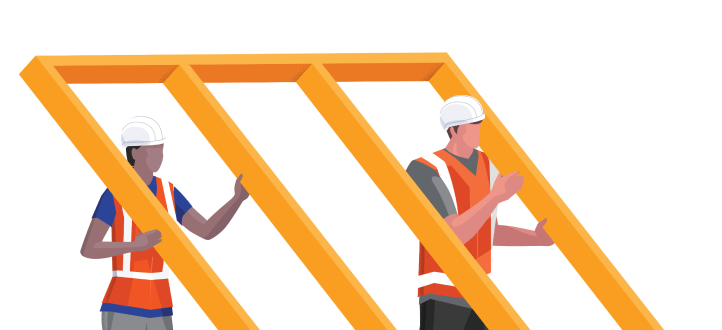— 7 min read
A Guide to Defect Lists in Construction
Last Updated Dec 8, 2023

When you're managing a construction project, it can feel like the tasks never end. New issues arise that need to be tackled, and then there are old tasks that sneak up on you and require a revisit. With so many moving parts, you need something to make life easier and the final construction walkthrough a breeze. Enter, defect lists.
In construction project management, defect lists are a common practice to help you ensure that all the project specifications match the contract. Here, we dive into what a defect list is, how key stakeholders interact with defect lists and what you can do to improve the defect list process.
Table of contents
What is a defect list?
A defect list is an itemised checklist of outstanding tasks needing attention. Also called a snag list or deficiency list, a construction defect list includes any work that was not completed according to specifications or any items that need correction, such as incorrect installs or improper building functionality. Defect list items are usually smaller fixes, and this is because larger issues typically come with urgency and have already been addressed through a variation.
Here are a few examples of common defect list items:
- Repair broken window
- Replace chipped baseboards
- Touch up paint on ceilings
- Replace the cracked bathroom mirror
- Clear out debris in the back patio
As you can see, a defect list is comprised of small, lingering to-dos that need attention before a construction final walkthrough—or, what is sometimes referred to as a "punch out". With this in mind, every project manager's goal is to achieve a "zero defect list" before the final walk-through takes place.
How Stakeholders Interact With a Defect List
No one person can be solely responsible for ensuring all items are crossed or "punched" off the defect list—that would be overwhelming. There are multiple key stakeholders involved in the defect list process, including owners, head contractors, subcontractors and architects.
Owner
The owner's, or the client's, main responsibility is to be present towards the end of the project and inspect the work. As the project approaches completion, the owner should visit the worksite to survey what has been done. This is a good time for the owner to inspect work, ask questions and provide any direction or final requests. These items make their way onto the defect list.
Head Contractor
The head contractor has many roles in the defect list process. Because they act as a liaison between the owner, subcontractors and architect, they are central to the entire process. Their responsibilities include:
- Populating the owner's requests and comments into the defect list
- Examining what's left to be done and adding any additional items necessary to the defect list
- Allocating remaining tasks and responsibilities to subcontractors
- Determining a realistic project completion date based on the defect list and communicating that information to all stakeholders involved
- Ensure defect list completion before the final construction walk-through
Subcontractors
Subcontractors will receive a list of tasks from the head contractor and need to address each task by the time requested. Subcontractors should also be prepared to answer any questions when it comes to these line items. For example, if a subcontractor is assigned to repair pavement cracks, the owner or head contractor may ask how the repair was done.
There may also be some cases where the subcontractor doesn't complete a task to the exact specifications on the defect list. This might be because the request wasn't viable and they used expertise and best judgment to get the job done in the most effective way possible. In these cases, the subcontractor should be prepared to articulate how and why.
Architect
During the final construction walkthrough, the architect is needed to confirm that what was designed was actually built. Before the final walkthrough, architects are also responsible for approving any changes in construction design that were necessary, and this needs to be accounted for during the final walkthrough.
Improving the Defect List Process
Defect lists are fundamental to any construction project. While a simple list on a piece of paper or an Excel spreadsheet can suffice, large projects can have extensive defect list items that can get lost on paper or in excel. There are ways to make the defect list process easier on you and for everyone involved.
Document as you go.
Although it can be tempting to put off creating a defect list until the very end, your team can work more efficiently if you begin creating your defect list earlier on. By implementing a defect list from the start, you also set a tone for standards and workflow for everyone involved on the job. Documenting as you go is known as a "rolling defect list" or "defect-as-you-go" method. It involves a little more work upfront with consistent check-ins on work duties and progress, but it pays off dividends in the end.
Assign tasks to the appropriate person.
Sometimes items get added to a defect list in a flurry. Everyone knows that it needs to get done ASAP, but they don't know who is responsible for it. No matter how big or small the task is, each item on a defect list needs to be assigned to a specific person. If it's a task that involves multiple people, make sure to assign clear roles. For example, if three subcontractors are assigned to a task, is there someone who should be taking the lead and ownership of the task? Roles and responsibilities should always be clearly spelled out, as you can never just assume that everyone is on the same page. Accountability is critical.
Be clear on your asks.
We discussed assigning tasks to the right person but once those tasks are assigned, are you sure they completely understand the nature of the ask? The more descriptive and thorough a defect list is, the smoother everything flows. For instance, does the person you assigned several tasks to know when each task needs to be complete? Do they understand which tasks take priority over others? This is where it can be helpful to have a premade defect list template you can fill in. That way, you know you're covering all of your bases and being as thorough as possible. The more information you extend, the more likely your project will end in success.
Use images to document issues.
Does everyone know which bedroom you mean by the "back bedroom?" Are the chips or stains called out in the defect list recognisable to all? Sometimes, even as we do our best to describe something, it won't always click right away. Or, someone might not have the eagle-eye that you have and not understand the issue at hand. This is where images can help quickly communicate the what, how, where and why of what needs to be resolved—and cut down on confusion. Additionally, having photos provides your team with receipts of what issues actually existed and what was done to resolve those issues. This can help prevent you from having to redo work and can also help justify why things were done the way they were.
Optimise the process with software.
While pen and paper can get the job done, it only ends up adding extra work and stress to your plate. Pen and paper make it hard to keep track of all the moving parts involved in a defect list, and it makes it difficult to provide real-time updates to key stakeholders involved in the project. Even an Excel spreadsheet falls short of the other options that are out there now. Cloud-based construction defect list software keeps everyone informed and accountable at all times.
Making Final Walkthrough a Breeze
Construction defect list software allows you to keep a clear list of defect list items, assign responsibilities, track status and more. With a simple, intuitive interface and pre-loaded defect list templates, you can generate and update defect lists with minimal effort. When defect list software is mobile friendly, you can take your defect list with you on the worksite, where you can assign tasks, take photos and document issues directly in the field.
Categories:
Tags:
Written by
Emma De Francesco
13 articles
Emma is currently Strategic Product Consultant at Procore where she loves partnering with clients to help them achieve the best possible results. She has worked as a Project Manager in previous roles, responsible for overseeing small to medium-sized projects across various sectors including commercial, health and lifestyle, retail, government and hotels. Throughout these projects, she managed everything from project costs, program and quality & safety, to design management, procurement, and authority approvals.
View profileExplore more helpful resources

Workforce Scheduling in Construction: 8 Tips To Improve Labour Productivity
Proper scheduling of construction labour and resources can result in increased productivity, lower costs, and improved timelines, allowing for successful project completion. By understanding a project’s requirements, assessing the resources...
Jobsite Communication Best Practices for Head Contractors
Effective communication serves as the foundation for driving success in construction projects. From planning to execution, clear and efficient communication plays a crucial role in ensuring seamless coordination, minimising errors,...

How Cost-Plus Contracts Work in Construction
A cost-plus contract provides reimbursement for all of the costs associated with a construction project, plus a fee to account for the contractor’s overhead and profit. Construction project owners may...

Construction Insolvency: Preventive Strategies for Contractors & Builders
Construction is one of the most vulnerable industries for insolvency, and that’s during a typical economic climate. When you pile on challenges with supply chains and labour availability — in...
